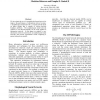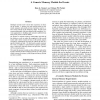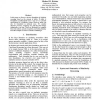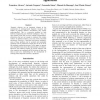FLAIRS
2007
14 years 1 months ago
2007
We describe an architecture for representing and managing context shifts that supports dynamic data interpretation. This architecture utilizes two layers of learning and three lay...
FLAIRS
2007
14 years 1 months ago
2007
As personal assistant software matures and assumes more autonomous control of its users’ activities, it becomes more critical that this software can explain its task processing....
FLAIRS
2007
14 years 1 months ago
2007
We investigate the use of a morphological neural network to improve the performance of information retrieval systems. A morphological neural network is a neural network based on l...
FLAIRS
2007
14 years 1 months ago
2007
Intelligent systems need to store their experience so that it can be reused. A memory for such systems needs to efficiently organize and search previous experience and to retriev...
FLAIRS
2007
14 years 1 months ago
2007
Ontologies are an increasingly important tool in knowledge representation, as they allow large amounts of data to be related in a logical fashion. Current research is concentrated...
FLAIRS
2007
14 years 1 months ago
2007
In this paper we discuss a rigorous foundation of similarity reasoning based on the concept of utility. If utility is formulated in mathematical terms it can serve as a formal spe...
FLAIRS
2007
14 years 1 months ago
2007
Information is indispensable in preparing economic decisions purposefully. In this paper knowledge is represented by a probability distribution. Knowledge acquisition is realized ...
FLAIRS
2007
14 years 1 months ago
2007
Semantic relations are an important element in the construction of ontology-based linguistic resources and models of problem domains. Nevertheless, they remain under-specified. Th...
FLAIRS
2007
14 years 1 months ago
2007
Many software applications consist of a number of interdependent steps and are executed under the supervision of a human administrator or operator. The administrator responds to e...
FLAIRS
2007
14 years 1 months ago
2007
Starting from the assumptions that human-ambient intelligence interaction will be improved by having more human-human like communications and that facial expressions are fundament...




